Toshiba Information Systems CC4-E01 Mobile Phone with UMTS/GSM/DCS/PCS & Bluetooth User Manual 2 of 3
Toshiba Information Systems (UK) Ltd, Mobile Communications Division Mobile Phone with UMTS/GSM/DCS/PCS & Bluetooth Users Manual 2 of 3
Contents
- 1. Users Manual 2 of 3
- 2. Users Manual 3 of 3
- 3. Users Manual 1 of 3
Users Manual 2 of 3

Basic Operations
65
◆Company: Allows you to enter a company name.
◆Birthday: Allows you to enter a birthday.
◆URL: Allows you to enter a URL.
◆Category: Allows you to set the category.
◆Picture: Allows you to set a picture to appear on the display for an incoming call.
◆Settings: Allows you to set the ringtone and other settings for incoming calls.
◆Note: Allows you to enter a reminder.
4. Enter the item and press .
5. Press (Options).
6. Select Save and press (Select).
Adding an Entry from Standby Mode
1. In standby mode, enter the phone number you want to add and press .
2. Select Add New Contact and press (Select).
To add the phone number to an existing Contacts list entry, select Add to Existing.
3. Proceed from Step 3 of “Adding an Entry from the Main Menu” (page 64).

66
Basic Operations
Incoming Settings
Setting a Picture
1. In Step 3 of “Adding an Entry from the Main Menu” (page 64), select Picture and
press (Options).
2. Select Change Picture and press (Select).
3. Select Take Picture or My Pictures and press (Select).
◆Take Picture: Activates the camera for you to take a picture. For details on
taking pictures, see page 102. After taking a picture, press .
◆My Pictures: Allows you to select a picture from My Items (page 196). To select
a file, press .
4. Press (Options).
5. Select Save and press (Select).
Note
• Copyright protected picture files
cannot be set.
• If a video file is set as the ringtone,
the video is displayed for incoming
calls and the picture set as the
incoming picture is not displayed.
Tip
To discard the picture setting, select
Remove Picture after Step 4.

Basic Operations
67
Setting the Ringtone
You can set the incoming external light, ringtone volume, ringtone pattern and vibration
settings individually for each Contacts list entry.
1. In Step 3 of “Adding an Entry from the Main Menu” (page 64), select Settings and
press (Options).
2. Select Select and press (Select).
3. Select the item you want to set and press (Select).
◆External Light: Allows you to set the colour of the incoming external light. Select
the colour you want to set and press (Select).
◆Ringtone Volume: Allows you to set the ringtone volume for incoming calls.
Select a ringtone type, select Set and set the volume.
◆Ringtones: Allows you to set the ringtone pattern for incoming calls or the
ringtone duration for incoming messages. Proceed from Step 4 of “Personalising
the Ringtone” (page 224).
◆Vibration: Allows you to set the vibration for incoming calls. Select a ringtone
type and select a vibration pattern.
4. Press (Back) once or twice to return to the Create Contact screen.
5. Press (Options).
6. Select Save and press (Select).
Tip
If you select Same as Phone in Step
3, the settings will be the same as
the corresponding settings of “Phone
Profiles” (page 222). The external
light setting will be the same as
corresponding setting of “Setting the
Incoming External Light” (page 235).
Note
When the phone profile (page 222) is
set to Silent, the ringtone does not
play.

68
Basic Operations
Editing Categories
Your phone already has the following categories: Business Card, Private, Friend,
Business, VIP and Colleague. In addition, you can set your own categories. You can
edit and set the options of categories. For each category, you can set the incoming
external light, ringtone volume, ringtone pattern and vibration.
Renaming a Category
1. In standby mode, press , select Contacts and press (Select).
2. Select Manage Category and press (Select).
3. Select a category and press .
4. Press (Options).
5. Select Edit and press (Select).
6. Enter the category name and press .
7. Select an icon and press (Select).
8. Press (Options).
9. Select Save and press (Select).
Note
Preset categories cannot be
renamed.

Basic Operations
69
Deleting a Category
1. After Step 2 of “Renaming a Category” (page 68), select the category you want to
delete and press (Options).
2. Select Delete and press (Select).
A confirmation screen appears.
3. Press (Yes).
All Contacts list entries for the deleted category are set to No Category.
Setting Options for a Category
1. After Step 3 of “Renaming a Category” (page 68), select Category Options and
press (Options).
2. Select Select and press (Select).
3. Proceed from Step 3 of “Setting the Ringtone” (page 67).
Note
Preset categories cannot be deleted.
To set all Contacts list entries for a
category to No Category, select
Reset after Step 1.
Note
The option settings for individual
entries (page 67) take priority over
the option settings for a category.
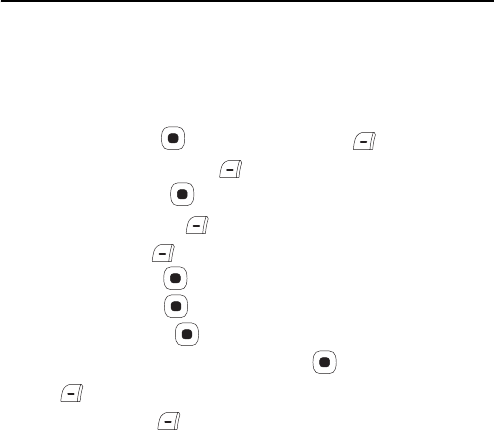
70
Basic Operations
Setting Groups
You can set the groups (broadcast lists) to use for MMS and email addresses. There are
five groups and you can add up to ten members to each group. For details on using the
Group list, see “Creating & Sending an MMS Message” (page 133) and “Creating &
Sending an Email Message” (page 157).
Adding a New Member to a Group
1. In standby mode, press , select Contacts and press (Select).
2. Select Manage Group and press (Select).
3. Select a group and press .
4. Select <Empty> and press (Options).
5. Select Add and press (Select).
6. Select Name and press .
7. Enter a name and press .
8. Select Send to and press .
9. Enter a phone number or email address and press .
10. Press (Options).
11. Select Save and press (Select).

Basic Operations
71
Adding a New Group Member from the Contacts List
1. After Step 4 of “Adding a New Member to a Group” (page 70), select Get Contacts
and press (Select).
2. Select the member you want to add and press .
The details of the selected member appear.
3. Select a phone number or email address and press .

72
Basic Operations
Editing Group Members
1. After Step 3 of “Adding a New Member to a Group” (page 70), select the member
you want to edit and press (Options).
2. Select Edit and press (Select).
3. Select the item you want to edit and press .
4. Enter the item and press .
5. Press (Options).
6. Select Save and press (Select).
Tip
You can perform the following
operations after Step 1.
•View: Displays the details of the
member.
•Delete: Deletes the selected
member.
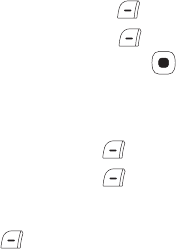
Basic Operations
73
Renaming a Group
1. After Step 2 of “Adding a New Member to a Group” (page 70), select the group you
want to rename and press (Options).
2. Select Rename and press (Select).
3. Enter the group name and press .
Resetting a Group
1. After Step 2 of “Adding a New Member to a Group” (page 70), select the group you
want to reset and press (Options).
2. Select Reset and press (Select).
A confirmation screen appears.
3. Press (Yes).
The group name is reset and all members are deleted from the group.
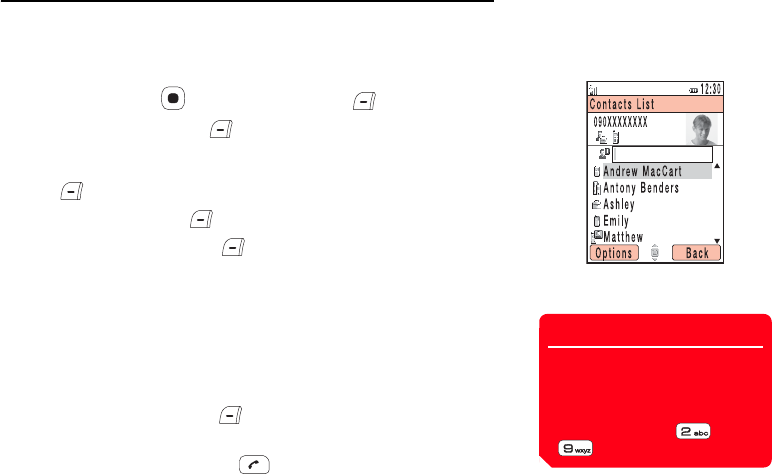
74
Basic Operations
Using the Contacts List
You can access a phone number or email address in the Contacts list and then make a
call or send an SMS, MMS or email message.
Searching for an Entry in the Contacts List
1. In standby mode, press , select Contacts and press (Select).
2. Select Contacts List and press (Select).
The Contacts list appears.
3. Press (Options).
4. Select Search by and press (Select).
5. Select a search method and press (Select).
◆First Name: Allows you to enter a letter of the alphabet. A list of Contacts list
entries with first names beginning with the letter of the alphabet you entered is
displayed.
◆Last Name: Allows you to enter a letter of the alphabet. A list of Contacts list
entries with last names beginning with the letter of the alphabet you entered is
displayed.
◆Phone Number: Displays the phone number input screen for entering a number.
After you enter a number, press (OK). A list of Contacts list entries with
phone numbers containing the number you entered is displayed.
6. Select a Contacts list entry and press to make a call to the default phone
number.
Contacts List Screen
Tip
In standby mode, you can display a
list of Contacts list entries with first
names beginning with the letters of
the alphabet assigned to a key if you
press and hold any of to
.

Basic Operations
75
Making a Call
1. In standby mode, press , select Contacts and press (Select).
2. Select Contacts List and press (Select).
The Contacts list appears.
3. Select the Contacts list entry you want to access and press .
The details screen of the entry appears.
4. Select the phone number you want to call and press .
To make a video call, press .
Sending a Message
1. After Step 3 of “Making a Call” (above), select a phone number or email address
and press (Options).
2. Select Send Message and press (Select).
3. Select a message type and press (Select).
◆SMS: Allows you to create an SMS message (page 144).
◆MMS: Allows you to create an MMS message (page 133).
◆Email: Allows you to create an email message (page 157).
Tip
• To access the Web page, select the
URL in the details screen of the
entry, press (Options) and
select Connect.
• To display the Create Postcard
screen (page 166), select the
postal address in the details screen
of the entry, press (Options)
and select live! Postcard.
Tip
You can perform the following
operations after Step 1. The options
that are available vary depending on
the item selected.
•View: Displays the details of the
selected item.
•Call: Allows you to select Voice
Call or Video Call to make a call.
•Edit: Allows you to edit the
selected item.
•Delete: Deletes the selected item.
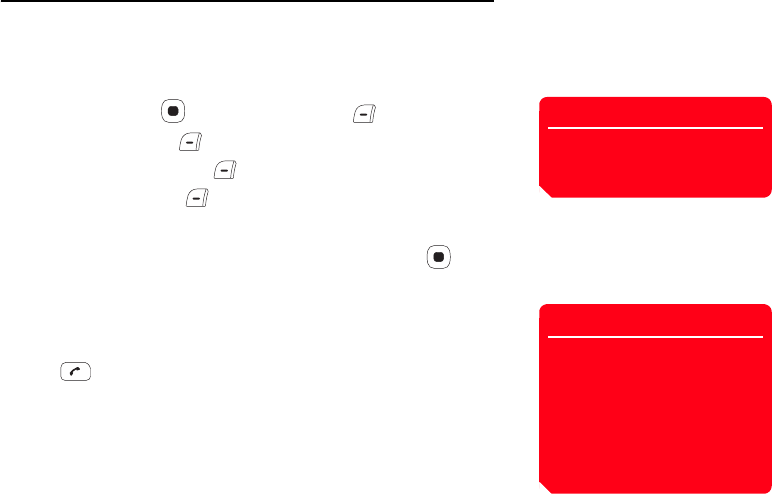
76
Basic Operations
Using Speed Calling
In standby mode, you can make calls quickly and easily to phone numbers in the Speed
Calling list. You can add up to nine phone numbers to the list.
Adding a Phone Number to the Speed Calling List
1. In standby mode, press , select Contacts and press (Select).
2. Select Settings and press (Select).
3. Select Speed Calling and press (Select).
4. Select <Empty> and press (Add).
The Contacts list appears.
5. Select the Contacts list entry to add to the Speed Calling list and press .
Using Speed Calling to Make Calls
1. In standby mode, enter the speed calling number of the phone number you want to
call.
2. Press .
Note
Only Contacts list entries in your
phone can be added to the Speed
Calling list.
Tip
• The speed calling number is
indicated beside the entry in the
Speed Calling list.
• If the Contacts list entry in the
Speed Calling list contains more
than one phone number, a call is
made to the default phone number
(page 78).

Basic Operations
77
Using Send My vCard
You can convert the owner information appearing in My Details to vObject format (page
203) and send it by infrared or Bluetooth™.
1. In standby mode, press , select Contacts and press (Select).
2. Select Send My vCard and press (Select).
3. Select a send method and press (Select).
◆Via Infrared: Sends the information by infrared (page 293).
◆Via Bluetooth: Sends the information by Bluetooth™ (page 289).
Using Synchronise
You can synchronise the Contacts list of your phone with a network server or data on a
PC. The supplied data management software My Mobile needs to be installed on the
PC. For details on the synchronisation procedure, see “Synchronising the Contacts List”
(page 302).
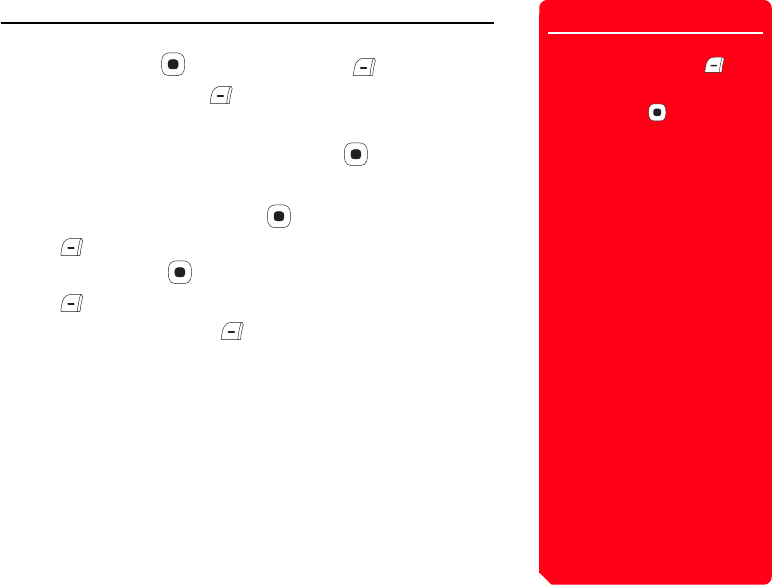
78
Basic Operations
Editing Contacts List Entries
You can edit and delete entries in the Contacts list individually.
1. In standby mode, press , select Contacts and press (Select).
2. Select Contacts List and press (Select).
The Contacts list appears.
3. Select the Contacts list entry you want to edit and press .
The details screen of the entry appears.
4. Select the item you want to edit and press .
5. Press (Edit).
6. Enter the item and press .
7. Press (Options).
8. Select the save method and press (Select).
◆Save: Saves the edited Contacts list entry by overwriting the original entry.
◆Save as New: Saves the edited Contacts list entry as a new entry.
Tip
• To edit the address, category,
picture or settings, press
(Options) after Step 3 and select
Edit. Select the item you want to
edit and press .
• You can set the following options
after Step 7. The options that are
available vary depending on the
item selected.
•Edit: Displays the input screen
of the selected item.
•Select: Displays the screen for
selecting the category, ringtone
and other options.
•Change Picture: Allows you to
change the picture.
•Change Type: Allows you to
change the phone number,
email address, postal address
and URL type.
•Set to Default: Sets the
selected phone number to the
default phone number.
•Remove Picture: Allows you to
delete the picture.
•Reset Settings: Allows you to
reset the ringtone and other
settings.
•Clear Field: Deletes the
selected item.
•Clear Category: Clears the
category setting.

Basic Operations
79
Options Available from the Contacts List
You can perform the following operations if you press (Options) from the Contacts
list.
◆View: Displays the details screen for one entry.
◆Search by: Allows you to search for an entry in the Contacts list (page 74).
◆Edit: Displays the edit screen for one entry.
◆Delete: Deletes one or all Contacts list entries.
◆Select Multi: Allows you to select multiple Contacts list entries and you can
perform each of the Delete, Copy, Move, Send vCard, View and Mark All
operations on multiple Contacts list entries simultaneously.
◆Send vCard: Converts a Contacts list entry to vCard format and sends it.
◆Memory Card: Displays a list of Contacts list entries in the memory card.
◆Phone/SIM: Displays a list of Contacts list entries in the phone and SIM card.
◆Sort by: Allows you to change the order that entries appear. You can select a sort
option from First Name, Last Name or Displayname.
◆Category Filter: Displays the Contacts list entries of the selected category.
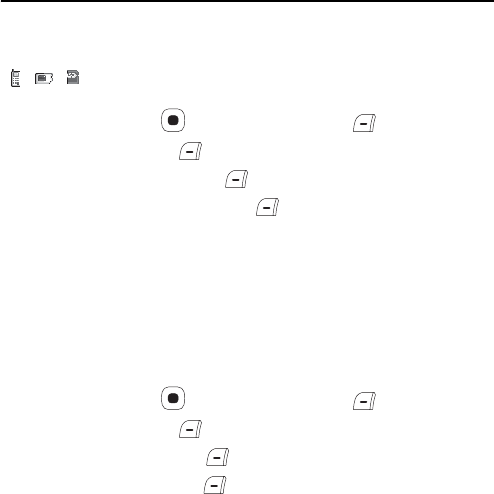
80
Basic Operations
Setting the Contacts List
Setting the Default Storage Place
You can preset the default storage place for new Contacts list entries. An indicator
( / / ) at the top of the Contacts list screen (page 74) indicates the storage
place of the Contacts list entry.
1. In standby mode, press , select Contacts and press (Select).
2. Select Settings and press (Select).
3. Select Default Storage and press (Select).
4. Select a default storage place and press (Select).
◆Always Ask: Asks you to select the storage place each time you save a new
entry.
◆Phone Memory: Saves all new entries to the Contacts list of your phone.
◆SIM: Saves all new entries to the Contacts list of the SIM card.
◆Memory Card: Saves all new entries to the Contacts list of the memory card.
Setting the Scroll Speed
You can set the speed for scrolling up and down in the Contacts list.
1. In standby mode, press , select Contacts and press (Select).
2. Select Settings and press (Select).
3. Select Scroll Speed and press (Select).
4. Select Fast or Slow and press (Select).
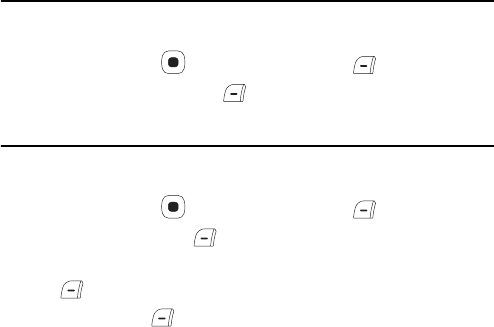
Basic Operations
81
Confirming the Memory Status
You can display the number of Contacts list entries in each of your phone, SIM card and
memory card.
1. In standby mode, press , select Contacts and press (Select).
2. Select Memory Status and press (Select).
Owner Information
You can display and edit owner information such as the phone number and email
address of your phone.
1. In standby mode, press , select Contacts and press (Select).
2. Select My Details and press (Select).
The owner information appears.
3. Press (Options).
4. Select Edit and press (Select).
Perform Steps 3 and 4 of “Adding an Entry from the Main Menu” (page 64).
82
Basic Operations

Video Telephony
A video call allows both you and the other party to see each other’s image during the call.
In This Chapter
❍About Video Calls
❍Making a Video Call
❍Answering a Video Call
❍Convenient Functions for Video Calls
❍Video Call Settings
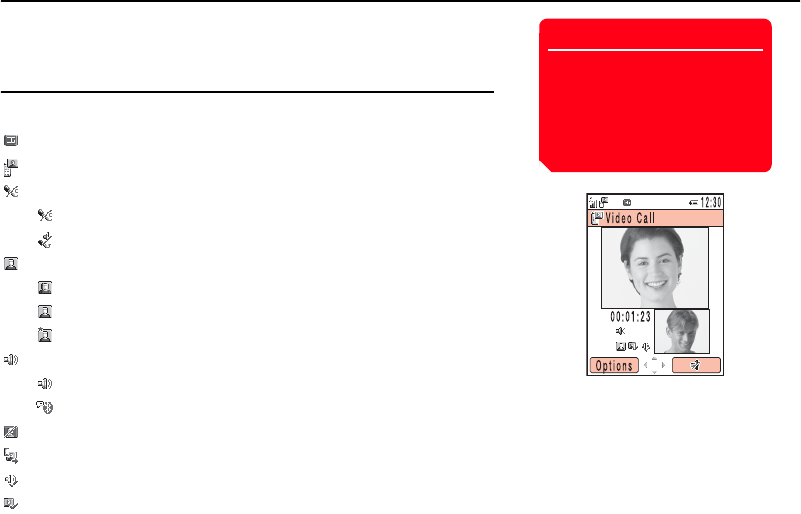
84
Video Telephony
About Video Calls
A video call allows two parties with video call compatible phones to see each other’s
image during the call.
Indicators
The following indicators appear during video calls.
3G Area
Video Call
Mute
Mute My Voice
Mute All
Picture Quality
Motion Prioritised
Standard Mode
Macro Mode
Handsfree On
Handsfree
Handsfree (Bluetooth™ connection)
Image Transfer Off
Sending Picture
Voice Connection Established
Video Connection Established
Note
• A video call is only possible in
areas with 3G-network coverage.
• The video call function of your
phone complies with the 3G-324M
international standard for 3G
mobile videophones.
Video Call Screen

Video Telephony
85
Making a Video Call
1. In standby mode, confirm that the indicator for indicating you are in an area
with 3G-network coverage is displayed.
2. Enter a phone number and press .
When a connection is established, both you and the other party see each other’s
image and can begin talking. The sound automatically switches from the earpiece
to the speaker, thus enabling you to begin a handsfree call.
When Appearance Check (page 95) is set to On, your image appears before the call
is made. After you have checked the image, press (OK).
3. Press to end the call.
Note
If a video call connection could not be
established, a message appears and
a warning tone plays. To make a
voice call instead, press (Yes).
Tip
You can also make a video call from
the Contacts list (page 74) or call log
(page 43).
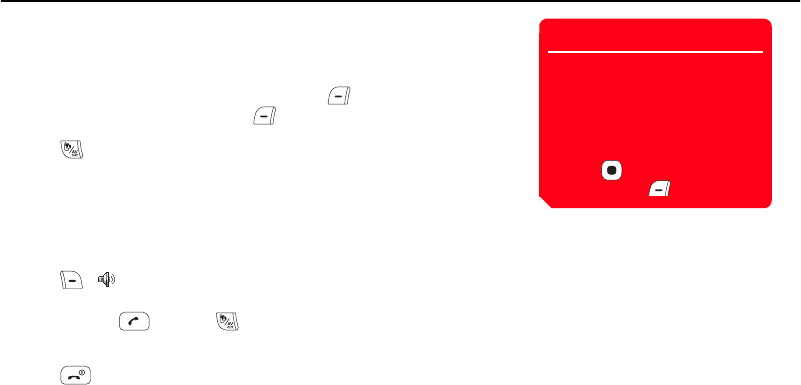
86
Video Telephony
Answering a Video Call
When a video call is received, the ringtone plays, the external light flashes and “Video
Call” appears on the display.
1. A video call is received.
To check your image before beginning the call, press (Options) when the call
is received, select Self-view and press (Select).
2. Press .
When a connection is established, both you and the other party see each other’s
image and can begin talking. The sound automatically switches from the earpiece
to the speaker, thus enabling you to begin a handsfree call. However, if the phone
profile (page 222) is set to Silent when a video call is received, the caller’s voice is
heard from the earpiece. To switch the sound from the earpiece to the speaker,
press ( ) during a call.
To set image transfer from the camera to off so as you can answer the call as a
voice call, press instead of . During the voice call, the substitute picture
set in the Outgoing Video settings (page 91) is sent to the other party.
3. Press to end the call.
Tip
• The procedures for rejecting calls
(page 40), diverting calls (page 49),
Any Key Answer (page 240) and
Open to Answer (page 240) are
identical to those for voice calls.
• To place an incoming call on hold,
press . To answer a call placed
on hold, press (Unhold).
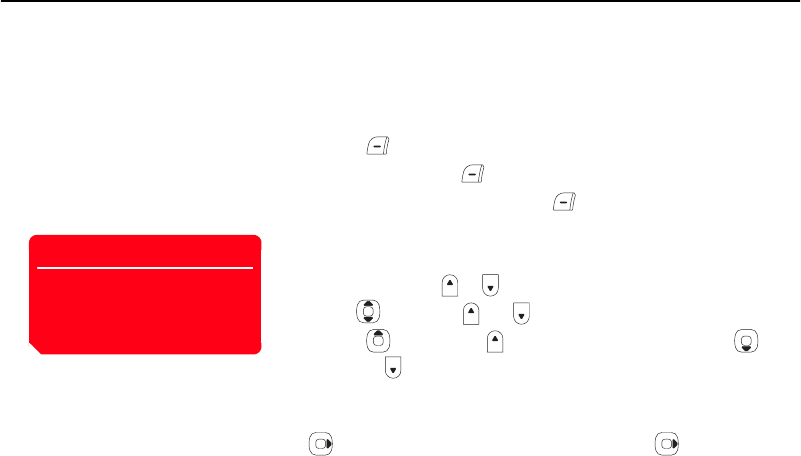
Video Telephony
87
Convenient Functions for Video Calls
The following convenient functions are available during calls.
Placing a Call on Hold
You can place a call on hold. While on hold, voice guidance notifies the other party that
he/she has been placed on hold. The other party is also sent the picture preset for the
Hold Guidance setting (page 94).
1. Press (Options) during a call.
2. Select Hold and press (Select).
To resume a call placed on hold, press (Unhold).
Adjusting the Speaker Volume
You can adjust the speaker volume during a call.
1. Press the side key ( or ) during a call.
2. Use or side keys ( and ) to adjust the volume.
Press or the side key ( ) to increase the volume level and press or the
side key ( ) to decrease the volume level.
Turning On/Off the Outgoing Voice
You can turn on/off the outgoing voice during a call. To turn off the outgoing voice, press
during a call. To turn the outgoing voice back on, press again.
Tip
If you have switched the sound to the
earpiece (page 88), you can use this
procedure to adjust the volume of the
earpiece.
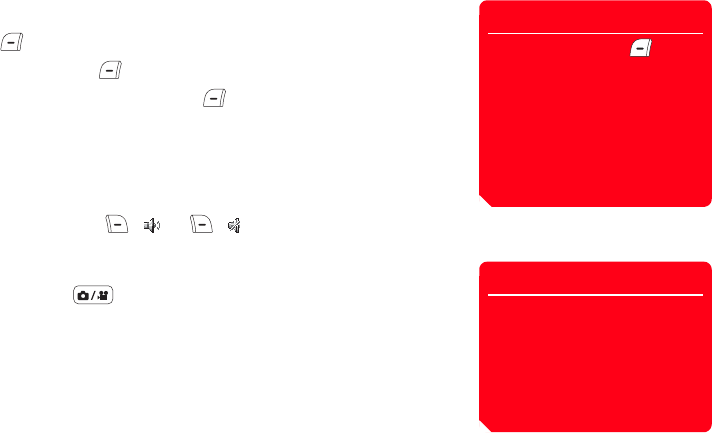
88
Video Telephony
Setting Mute
You can mute the incoming voice and outgoing voice during a call.
1. Press (Options) during a call.
2. Select Mute and press (Select).
3. Select the item you want to set and press (Select).
◆Mute My Voice: Mutes the outgoing voice.
◆Mute All: Mutes both the outgoing and incoming voice.
Switching between the Earpiece & Speaker
You can switch between the earpiece and speaker during a call. To switch between the
earpiece and speaker, press ( ) or ( ) during a call.
Switching Cameras
You can switch between the external camera and internal camera during a call. To
switch cameras, press during a call.
Tip
• To cancel mute, press
(Unmute).
• If you switch to turnover style
during a handsfree call, only the
output voice can be muted. If you
are using the supplied handsfree
stereo headset or a Bluetooth™
device to input your voice, the
outgoing voice cannot be muted.
Tip
When you switch from the internal
camera to the external camera, a
large outgoing image appears on the
display. When you switch from the
external camera to the internal
camera, a large incoming image
appears on the display.

Video Telephony
89
Using the Zoom
You can enlarge the image to be sent to the other party during a call.
To use the zoom, press during a call.
Switching Screen Display
You can select the screen display method during a call.
1. Press (Options) during a call.
2. Select Screen Settings and press (Select).
3. Select Switch Screens and press (Select).
4. Select the display method you want to set and press (Select).
◆Priority Incoming: Displays a large incoming screen and a small outgoing
screen.
◆Incoming Only: Displays only the incoming screen.
◆Priority Outgoing: Displays a small incoming screen and a large outgoing
screen.
◆Outgoing Only: Displays only the outgoing screen.
Turning On/Off the Outgoing Video
You can turn on/off the sending of images recorded with the camera during a call. To
turn off the outgoing video, press during a call. To turn the outgoing video back on,
press again.
Note
The zoom is disabled while sending a
picture (page 90) or when image
transfer is set to off.
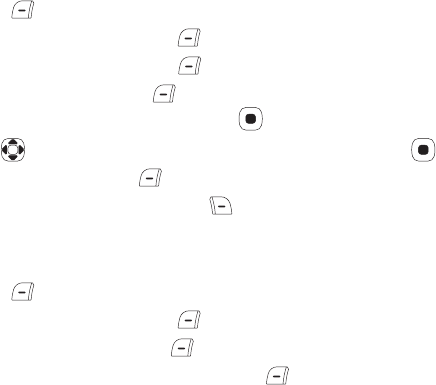
90
Video Telephony
Sending a Picture
You can send a picture in My Items during a call.
1. Press (Options) during a call.
2. Select Screen Settings and press (Select).
3. Select Sending Picture and press (Select).
4. Select My Pictures and press (Select).
5. Select the picture you want to send and press .
6. Use to adjust the position of the picture within the dotted line and press .
7. Check the picture and press (Set).
To cancel the sending of a picture, press (Stop).
Setting the Picture Quality
You can set the quality and motion speed of the incoming video.
1. Press (Options) during a call.
2. Select Screen Settings and press (Select).
3. Select Picture Quality and press (Select).
4. Select the output format you want to set and press (Select).
◆Motion Prioritised: Gives priority to video motion.
◆Standard Mode: Standard output format.
◆Macro Mode: Gives priority to picture quality.

Video Telephony
91
Video Call Settings
You can set various video call settings.
Setting the Outgoing Image
You can preset the outgoing image to send during a video call.
1. In standby mode, press , select Outgoing Video and press (Select).
2. Select the item you want to set and press (Select).
◆Camera Monitored: Sends video images recorded during a call.
◆My Pictures: Allows you to select a picture to send from the Picture folder of My
Items. Select the picture you want to send, press and then press (Set).
◆No Picture: Sends a preinstalled picture in your phone.
Note
You can send pictures of QVGA
(W240 × H320) size or smaller.

92
Video Telephony
Setting Auto Answer for Video Calls
When the Auto Answer function for video calls is set, video calls received from phone
numbers in the Auto Answer list (page 93) are answered automatically without having to
press a key.
1. In standby mode, press , select Auto Answer and press (Select).
2. Select Mode Setting and press (Select).
3. Select On or Off and press (Select).
Note
• The Auto Answer function for
incoming video calls is only
available while your phone is open.
Incoming video calls are received
as usual when your phone is
closed.
• If a video call is received from a
phone number in the Auto Answer
list while Auto Answer is set to On,
the Auto Answer tone plays and the
call is answered automatically
regardless of the Phone Profile
(page 222) settings.

Video Telephony
93
Adding a Phone Number to the Auto Answer List for Video Calls
You can add up to ten phone numbers to the Auto Answer list for video calls to enable
Auto Answer (page 92) to answer video calls from those phone numbers.
1. In standby mode, press , select Auto Answer and press (Select).
2. Select Auto Answer List and press (Select).
3. Press (Add).
4. Enter your security code (page 38).
5. Select a phone number input method and press (Select).
◆From Contacts: Allows you to select a phone number from the Contacts list
(page 74).
◆Set Number: Allows you to directly enter a phone number.
◆From Call Log: Allows you to select a phone number from the call log (page 43).
To add a second or subsequent phone number, press (Options) after Step 2.
Then, select Add and proceed from Step 4.
Tip
To check, edit or delete the phone
number, select the phone number
and press (Options) after Step
3.

94
Video Telephony
Setting the Backlight
You can set whether the backlight is lit during an appearance check or video call.
1. In standby mode, press , select Backlight and press (Select).
2. Select On or Off and press (Select).
Hold Guidance Settings
You can set the picture displayed to the other party when you place an incoming video
call or video call in progress on hold.
1. In standby mode, press , select Hold Guidance and press (Select).
2. Select the item you want to set and press (Select).
◆Hold Answer: Allows you to set the hold guidance for incoming calls.
◆Hold during Call: Allows you to set the hold guidance for calls in progress.
3. Select the image type you want to set and press (Select).
◆Preset Picture: Allows you to set the default picture.
◆My Pictures: Allows you to select a picture from the Pictures folder of My Items.
Select the picture you want to set, press and then press (Set).
Note
• You can send pictures of QVGA
(W240 × H320) size or smaller.
• A copyright protected picture
cannot be selected.

Video Telephony
95
Setting Appearance Check
This feature allows you to check the image to send to the other party before making a
video call.
1. In standby mode, press , select Appearance Check and press (Select).
2. Select On or Off and press (Select).
96
Video Telephony

Camera/Video Camera
You can take pictures and record videos and then save them, attach them to messages and
display them on a TV. You can also edit pictures.
In This Chapter
❍Camera
❍Pictures
❍Videos
❍Picture & Video Settings
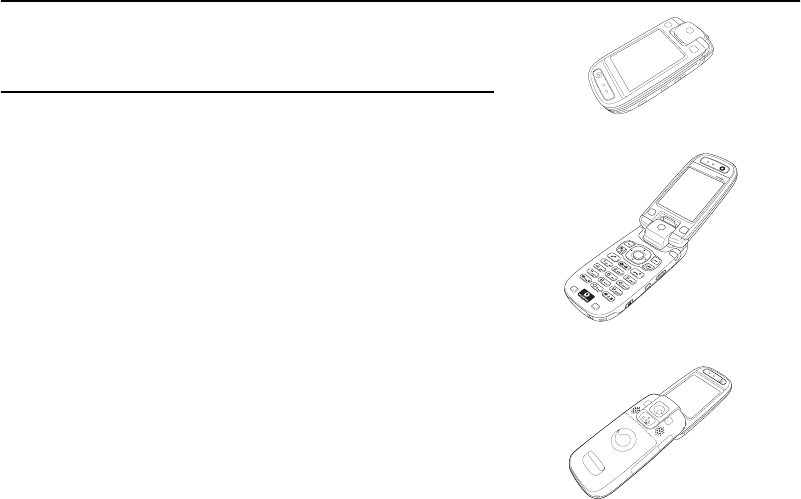
98
Camera/Video Camera
Camera
You can use the camera to take pictures and record videos, as well as to scan QR code
barcodes (page 279).
Modes
Change the orientation of the phone according to the mode.
Modes for Taking Pictures
◆Landscape Mode: Allows you to take high-quality pictures at VGA or higher
resolution.
◆Portrait Mode: Allows you to take pictures at QVGA size or smaller for use as
wallpaper, etc.
◆Scanner: Allows you to scan QR code barcodes. For details, see “Barcode” (page
278).
Modes for Recording Videos
◆Camcorder: Allows you to record videos up to approximately 20 minutes long.
The recording time depends on the amount of available memory in the storage
place.
◆For MMS: Allows you to record videos for sending attached to MMS messages.
Turnover Style
Style for Landscape Mode and Camcorder
Open Style
Style for Portrait Mode and For MMS
Self-portrait Style
Style for taking pictures and recording videos
of yourself
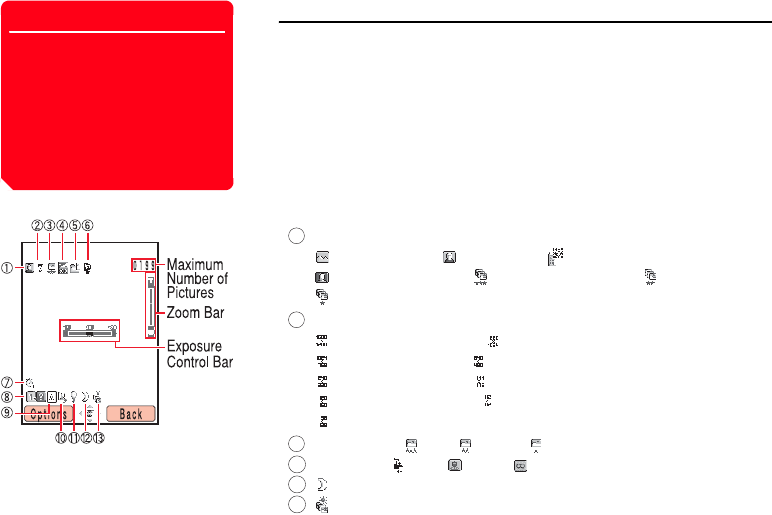
Camera/Video Camera
99
Screens
About Screens
There are two camera/video camera screens: the monitor screen and preview screen.
◆Monitor screen: The standby screen that appears from when you activate the
camera/video camera until when you begin taking a picture or recording a video.
◆Preview screen: The screen that appears after taking a picture or recording a
video to allow you to view the picture or video.
Explanation of Indicators
Camera Indicators
Picture Mode/Multi Shots:
Landscape Mode, Portrait Mode, Scanner,
Internal Camera in Use, Multi Shots (High Speed), (Normal Speed),
(Low Speed)
Picture Size:
W1600 × H1200 (UXGA), W1280 × H1024 (SXGA),
W1024 × H768 (XGA), W640 × H480 (VGA),
W240 × H320 (QVGA), W144 × H176 (QCIF),
W120 × H160 (QQVGA), W112 × H112 (Caller ID),
W96 × H128 (Sub QCIF)
Picture Quality: Fine, Normal, Economy
Focus Mode: Auto, Macro, Infinity
Night Mode
Auto Bracket
Note
Soft keys appear on the monitor
screen at the following times:
• When you take pictures in Portrait
mode of open style or self-portrait
style.
• When you record videos in For
MMS of open style or self-portrait
style.
Camera Monitor Screen
1
2
3
6
12
13
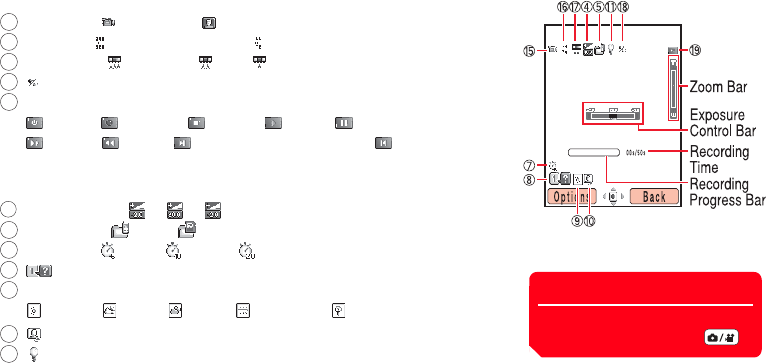
100
Camera/Video Camera
Video Camera Indicators
Video Mode: Video Mode, Internal Camera in Use
Video Size: W320 × H240 (QVGA), W176 × H144 (QCIF)
Video Quality: Super Fine, Fine, Normal
Voice Record Off
Status:
Standby, Recording, Stopped, Playing, Paused,
Forward, Rewind, Frame Forward/Slow Playback, Frame Rewind
Camera & Video Camera Indicators
Exposure Control: ... ... -2.0 ... ±0 ...+2.0
Storage Place: Phone, Memory Card
Delay Timer: 5 sec., 10 sec., 20 sec.
Guide Display
White Balance:
Daylight, Shade, Cloudy, Fluorescent, Tungsten
Self-view
Mobile Light
Video Monitor Screen
Tip
To switch between the camera and
video camera, press and hold .
15
16
17
18
19
4
5
7
8
9
10
11
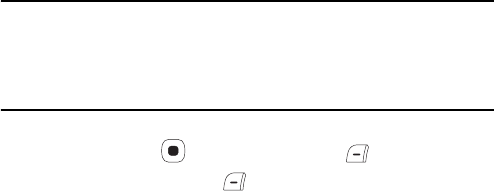
Camera/Video Camera
101
TV Display
You can display pictures/videos from the monitor screen or preview screen on a TV. The
TV systems supported by your phone are the NTSC and PAL systems. The SECAM
system is not supported. For details, see “Displaying Files on a TV” (page 201).
Confirming the Memory Status
You can confirm the usage status of your phone and memory card.
1. In standby mode, press , select Camera and press (Select).
2. Select Memory Status and press (Select).
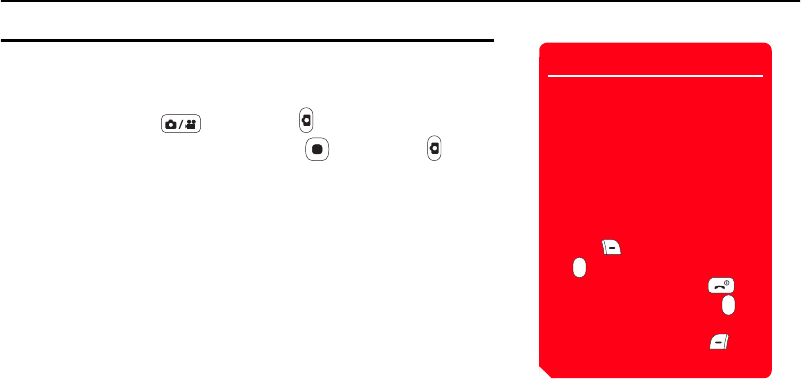
102
Camera/Video Camera
Pictures
Taking a Picture
You can use the camera to take pictures. There are two modes for taking pictures:
Landscape mode and Portrait mode (page 98). You can also edit the pictures you take
and set them for Contacts list entries.
1. In standby mode, press or the side key ( ).
2. Display the subject in the main display and press or the side key ( ).
The shutter sound is heard and the picture is saved automatically to the preset
storage place (page 125).
Tip
• If the Preview setting (page 128) is
set to On, the preview screen
appears after the picture is saved
automatically.
• If the picture was taken in
Landscape mode, you can adjust
the zoom in the preview screen.
•
To return to the monitor screen so
as you can take another picture,
press (Back) or the side key
().
• To end the camera, press or
press and hold the side key ( ).
• To set the Full Screen setting from
the preview screen, press
(Options) and select Full Screen.
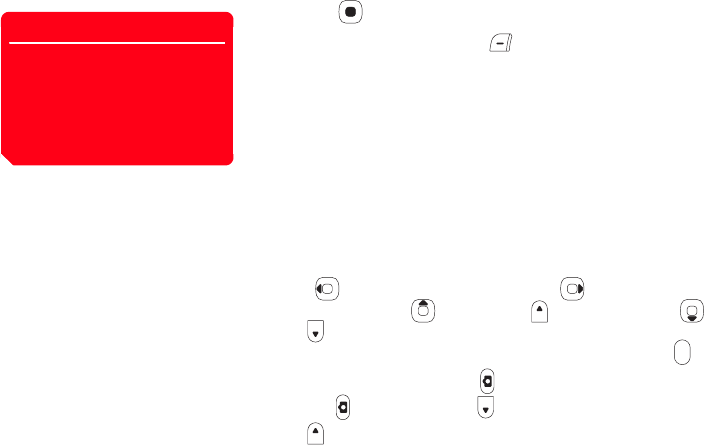
Camera/Video Camera
103
Preview Screen Send Functions
1. Press from the preview screen.
2. Select a send method and press (Select).
◆As MMS: Allows you to send the picture attached to an MMS message (page
133).
◆live! Postcard: Allows you to attach the picture to an MMS message and send it
as a postcard (page 166).
◆To live! Studio: Allows you to upload the picture to a media album on the Web
(page 169).
◆Via Infrared: Allows you to send the picture by infrared (page 293).
◆Via Bluetooth: Allows you to send the picture by Bluetooth™ (page 289).
Key Operations
You can adjust the exposure and zoom from the monitor screen. To adjust the exposure,
press to make the picture darker and press to make the picture lighter. To
adjust the zoom, press or the side key ( ) to zoom in and press or the side
key ( ) to zoom out.
To adjust the exposure while in the turnover style, press the side key ( ), select
Advanced and press the side key ( ). Then, select Exposure Control and press the
side key ( ). Press the side key ( ) to make the picture darker and press the side
key ( ) to make the picture lighter.
Note
• Some send functions may be
unavailable depending on the SIM
card inserted.
• If the Preview setting (page 128) is
set to Off, the picture cannot be
sent.
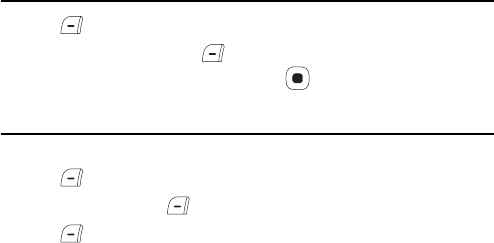
104
Camera/Video Camera
Picture Sizes
For details on setting the picture size, see “Changing the Picture Size” (page 120).
◆Landscape Mode: Allows you to select a picture size from W1600 × H1200
(UXGA), W1280 × H1024 (SXGA), W1024 × H768 (XGA) and W640 × H480
(VGA).
◆Portrait Mode: Allows you to select a picture size from W240 × H320 (QVGA),
W144 × H176 (QCIF), W120 × H160 (QQVGA), W112 × H112 (Caller ID) and
W96 × H128 (Sub QCIF).
Viewing a Picture
1. Press (Options) from the monitor screen.
2. Select My Pictures and press (Select).
3. Select the picture you want to view and press .
Deleting a Picture
You can delete the picture displayed in the preview screen.
1. Press (Options) from the preview screen.
2. Select Delete and press (Select).
3. Press (Yes).
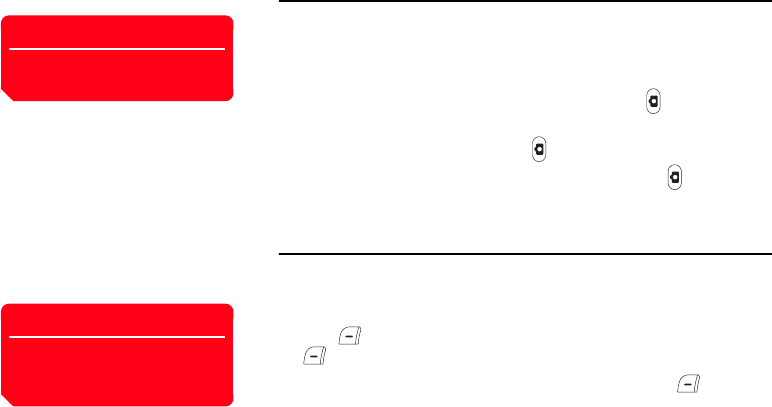
Camera/Video Camera
105
Default Recipient for MMS
Immediately after you take a picture in turnover style, you can send it attached to an
MMS message to the address preset for the default recipient (page 143). The maximum
picture size and file size for sending a picture are predetermined. If the picture exceeds
a predetermined size, it is compressed and then sent.
1. After you take a picture in turnover style, press the side key ( ) from the preview
screen.
2. Select As MMS and press the side key ( ).
If the picture was taken in Landscape mode, press the side key ( ) after the
compressed picture appears.
Functions for Taking Pictures
Switching Camera Modes
For details on camera modes, see “Modes for Taking Pictures” (page 98).
1. Press (Options) from the monitor screen, select Camera Mode and press
(Select).
2. Select Landscape Mode, Portrait Mode or Scanner and press (Select).
Note
If the Preview setting (page 128) is
set to Off, the picture cannot be sent.
Tip
For details on changing the picture
size in Landscape mode and Portrait
mode, see page 120.

106
Camera/Video Camera
Focus Mode
1. Press (Options) from the monitor screen, select Focus Mode and press
(Select).
2. Select the item you want to set and press (Select).
◆Auto: Adjusts the focus automatically.
◆Macro: Suitable for taking a picture of a subject that is very close to you.
◆Infinity: Suitable for taking a picture of a subject that is very far away from you.
Night Mode
You can use this mode for taking pictures of night scenes, etc.
1. Press (Options) from the monitor screen, select Night Mode and press
(Select).
2. Select On or Off and press (Select).
Tip
To adjust the focus when Auto is set,
press or half press the side key
( ) from the monitor screen. After
the focus is adjusted, the complete
sound is heard and the focus is
locked.
Note
• If night mode is set, Auto of focus
mode is unavailable.
• If multi shots or auto bracket is set,
night mode is unavailable.

Camera/Video Camera
107
Multi Shots
You can take up to nine pictures in succession.
1. Press (Options) from the monitor screen, select Multi Shots and press
(Select).
2. Select High Speed, Normal Speed, Low Speed or Off and press (Select).
Note
• If auto bracket is set, multi shots is
unavailable.
• If multi shots is set, the zoom
cannot be adjusted.
Tip
To delete a picture, select the picture
you want to delete after Step 2 of
“Deleting a Picture” (page 104),
press to add a check mark,
press (Options) and select
Delete.

108
Camera/Video Camera
Frame Setting
You can set the frame to add before you take a picture. For details on setting a frame
afterwards, see page 111.
1. Press (Options) from the monitor screen, select Add Frame and press
(Select).
2. Select Preset Frames or My Pictures and press (Select).
A list of frames appears.
3. Select the frame you want to add from the list and press .
The frame appears in the monitor screen.
To display the previous or next frame of the list, press or .
4. Press (OK).
Note
When taking pictures in Landscape
mode or at Sub QCIF size, a frame
cannot be set.

Camera/Video Camera
109
Auto Bracket
You can take three pictures of the same subject at different exposure levels. By
comparing all three pictures, you can choose the optimal exposure level.
1. Press (Options) from the monitor screen, select Advanced and press
(Select).
2. Select Auto Bracket and press (Select).
3. Select On or Off and press (Select).
Additional Functions for Taking Pictures
◆Self-view (page 125)
◆Storage Place (page 125)
◆Delay Timer (page 126)
◆Mobile Light (page 126)
◆White Balance (page 127)
◆Exposure Control (page 127)
Note
• When taking pictures in Landscape
mode, auto bracket cannot be set.
• If multi shots is set, auto bracket is
unavailable.
• If auto bracket is set, the zoom
cannot be adjusted.
Tip
To delete a picture, select the picture
you want to delete after Step 2 of
“Deleting a Picture” (page 104),
press to add a check mark,
press (Options) and select
Delete.
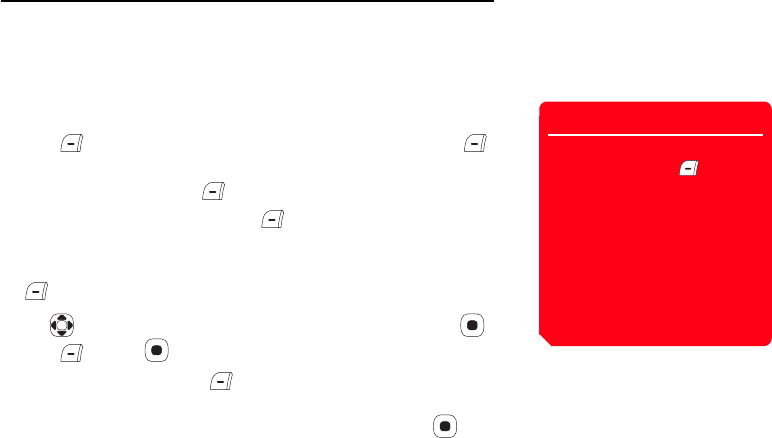
110
Camera/Video Camera
Editing a Picture
You can edit the picture in the preview screen of Portrait mode or pictures saved to My
Items. You can edit any picture that is a JPEG or PNG file of QVGA size or smaller with
100,000 pixels or less.
Changing the Picture Size
You can change the sizes of the pictures you take.
1. Press (Options) from the preview screen, select Edit Picture and press
(Select).
2. Select Picture Size and press (Select).
3. Select a picture size or Define and press (Select).
The selected picture size is indicated by a dotted line.
If you selected Define, enter a picture size (W16 to 240 × H16 to 320) and press
(OK).
4. Use to adjust the position of the picture within the dotted line and press .
5. Press (OK) and .
6. Select a save method and press (Select).
◆Save: Overwrites the file of the original picture.
◆Save as: Saves the picture as a new file. Enter a file name and press .
Tip
You can perform the following
operations if you press (Options)
after Step 3.
•Cut: Trims the image to fit the
selected picture size.
•Fit to Width: Resizes the picture to
fit the width of the selected picture
size.
•Fit to Length: Resizes the picture
to fit the height of the selected
picture size.
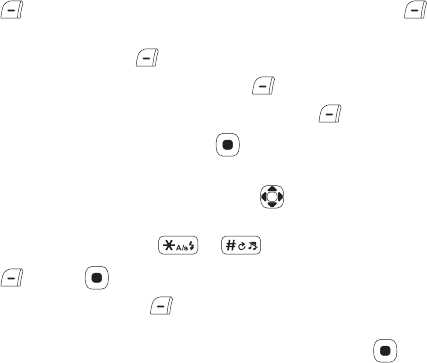
Camera/Video Camera
111
Adding a Frame
You can add frames to the pictures you take. You can select a frame from preinstalled
frames or frames saved to My Items.
1. Press (Options) from the preview screen, select Edit Picture and press
(Select).
2. Select Add Frame and press (Select).
3. Select Preset Frames or My Pictures and press (Select).
If you selected Preset Frames, select a frame size and press (Select).
4. Select the frame you want to add and press .
The framed picture appears.
If the frame size and picture size differ, you can use to adjust the position of
the frame.
To switch to another frame, press or .
5. Press (OK) and .
6. Select a save method and press (Select).
◆Save: Overwrites the file of the original picture.
◆Save as: Saves the picture as a new file. Enter a file name and press .
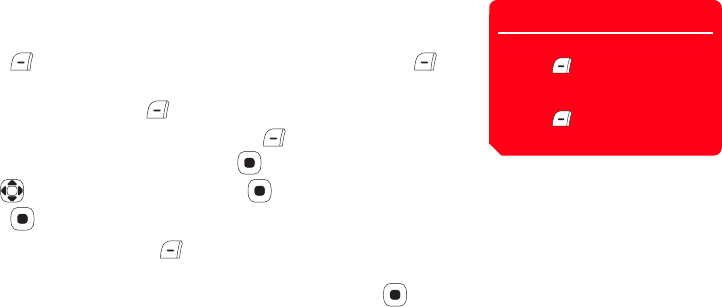
112
Camera/Video Camera
Adding a Stamp
You can paste stamps on the pictures you take. You can select a stamp from
preinstalled stamps or stamps saved to My Items.
1. Press (Options) from the preview screen, select Edit Picture and press
(Select).
2. Select Add Stamp and press (Select).
3. Select Preset Stamps or My Pictures and press (Select).
4. Select the stamp you want to paste and press .
5. Use to adjust the paste position and press .
6. Press twice.
7. Select a save method and press (Select).
◆Save: Overwrites the file of the original picture.
◆Save as: Saves the picture as a new file. Enter a file name and press .
Tip
• To paste the same stamp again,
press (Options) after Step 5
and select Continue.
• To undo the pasting of a stamp,
press (Options) after Step 5
and select Undo All.

Camera/Video Camera
113
Adding Text
You can add text to the pictures you take.
1. Press (Options) from the preview screen, select Edit Picture and press
(Select).
2. Select Add Text and press (Select).
3. Select Large Font, Standard Font or Small Font and press (Select).
4. Select a font colour and press (Select).
5. Enter text and press .
You can enter up to 18 characters with the large font, 24 characters with the
standard font and 40 characters with the small font.
6. Use to adjust the paste position and press (Paste).
7. Press .
8. Select a save method and press (Select).
◆Save: Overwrites the file of the original picture.
◆Save as: Saves the picture as a new file. Enter a file name and press .

114
Camera/Video Camera
Rotating a Picture
You can rotate and then save the pictures you take.
1. Press (Options) from the preview screen, select Edit Picture and press
(Select).
2. Select Rotate Image and press (Select).
3. Select the angle to which you want to rotate the picture and press (Select).
◆90 degrees: Rotates the picture 90 degrees clockwise.
◆180 degrees: Rotates the picture 180 degrees.
◆270 degrees: Rotates the picture 270 degrees clockwise (90 degrees
anticlockwise).
4. Press (OK) and .
5. Select a save method and press (Select).
◆Save: Overwrites the file of the original picture.
◆Save as: Saves the picture as a new file. Enter a file name and press .

Camera/Video Camera
115
Caller ID
You can register a picture taken in Portrait mode at Caller ID size (page 104) to a
Contacts list entry and set it to be displayed as the incoming picture along with the
name and phone number.
1. After you take a picture at Caller ID size, press (Options) from the preview
screen, select Assign to Contact and press (Select).
2. Select Add New Contact and press (Select).
To add the picture to an existing Contacts list entry, select Add to Existing.
3. Proceed from Step 3 of “Adding an Entry from the Main Menu” (page 64).
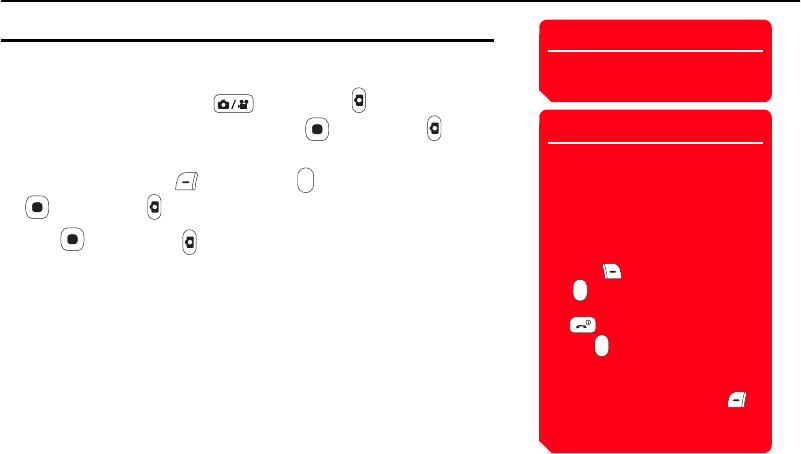
116
Camera/Video Camera
Videos
Recording a Video
You can use the camera to record videos. There are two modes for recording videos:
Camcorder and For MMS (page 98).
1. In standby mode, press and hold or the side key ( ).
2. Display the subject in the main display and press or the side key ( ).
The start sound is heard and recording begins.
To pause recording, press or the side key ( ). To resume recording, press
or the side key ( ).
3. Press or the side key ( ).
The end sound is heard and the video is saved automatically to the preset storage
place (page 125).
Note
A video being recorded in For MMS
cannot be paused.
Tip
• If the Preview setting (page 128) is
set to On, the first frame of the
video appears in the preview
screen after the video is saved
automatically.
• To return to the monitor screen so
as you can record another video,
press (Back) or the side key
().
• To end the video camera, press
or press and hold the side
key ( ).
• To set a video recorded in For MMS
as an incoming ringtone (page 67)
of a Contacts list entry, press
(Options) from the preview screen
and select Assign to Contact.
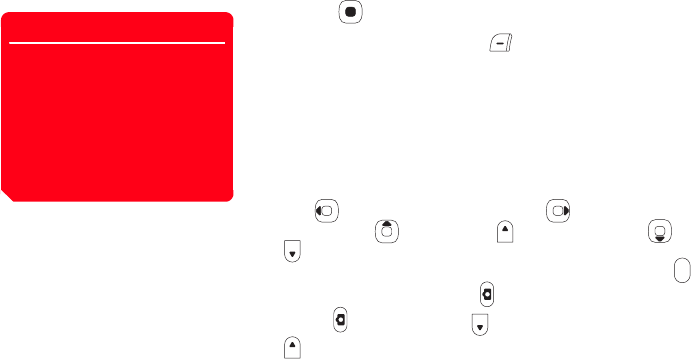
Camera/Video Camera
117
Preview Screen Send Functions
1. Press from the preview screen.
2. Select a send method and press (Select).
◆As MMS: Allows you to send the video attached to an MMS message (page 133).
◆To live! Studio: Allows you to upload the video to a media album on the Web
(page 169).
◆Via Infrared: Allows you to send the video by infrared (page 293).
Key Operations
You can adjust the exposure and zoom from the monitor screen. To adjust the exposure,
press to make the video darker and press to make the video lighter. To adjust
the zoom, press or the side key ( ) to zoom in and press or the side key
( ) to zoom out.
To adjust the exposure while in the turnover style, press the side key ( ), select
Advanced and press the side key ( ). Then, select Exposure Control and press the
side key ( ). Press the side key ( ) to make the video darker and press the side key
( ) to make the video lighter.
Video Sizes
◆Camcorder: Records at the QVGA (W320 × H240) video size. You can save up to
approximately 20 minutes of video to your phone or memory card. The recording
time depends on the amount of available memory in the storage place.
◆For MMS: Records at the QCIF (W176 × H144) video size. You can send videos
attached to MMS messages.
Note
• Videos recorded in Camcorder
cannot be sent.
• Some send functions may be
unavailable depending on the SIM
card inserted.
• If the Preview setting (page 128) is
set to Off, the video cannot be
sent.
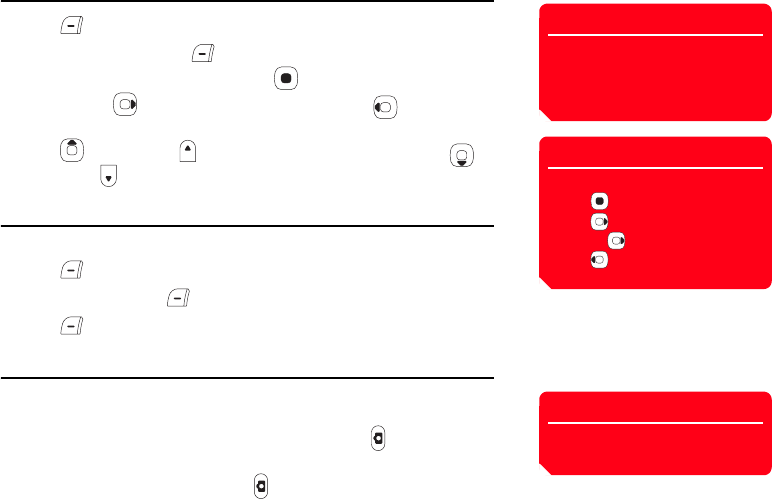
118
Camera/Video Camera
Playing a Video
1. Press (Options) from the monitor screen.
2. Select My Videos and press (Select).
3. Select the video you want to play and press .
Press and hold to forward the video and press and hold to rewind the
video.
Press or the side key ( ) to increase the playback volume and press or
the side key ( ) to decrease the playback volume.
Deleting a Video
You can delete the video displayed in the preview screen.
1. Press (Options) from the preview screen.
2. Select Delete and press (Select).
3. Press (Yes).
Default Recipient for MMS
Immediately after you record a video in For MMS of turnover style, you can send it
attached to an MMS message to the address preset for the default recipient (page 143).
1. After you record a video in turnover style, press the side key ( ) from the preview
screen.
2. Select As MMS and press the side key ( ).
Note
If a video was recorded in For MMS,
forward, rewind, frame forward,
frame rewind and slow playback are
unavailable.
Tip
To pause a video during playback,
press . When a video is paused,
press for frame forward, press
and hold for slow playback and
press for frame rewind.
Note
If the Preview setting (page 128) is
set to Off, the video cannot be sent.
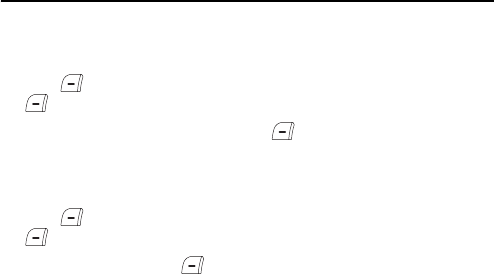
Camera/Video Camera
119
Functions for Recording Videos
Switching Record Modes
For details on record modes, see “Modes for Recording Videos” (page 98).
1. Press (Options) from the monitor screen, select Record Mode and press
(Select).
2. Select Camcorder or For MMS and press (Select).
Recording Sound
You can set whether to record sound during recording.
1. Press (Options) from the monitor screen, select Voice Record and press
(Select).
2. Select On or Off and press (Select).
Additional Functions for Recording Videos
◆Self-view (page 125)
◆Storage Place (page 125)
◆Delay Timer (page 126)
◆Mobile Light (page 126)
◆White Balance (page 127)
◆Exposure Control (page 127)
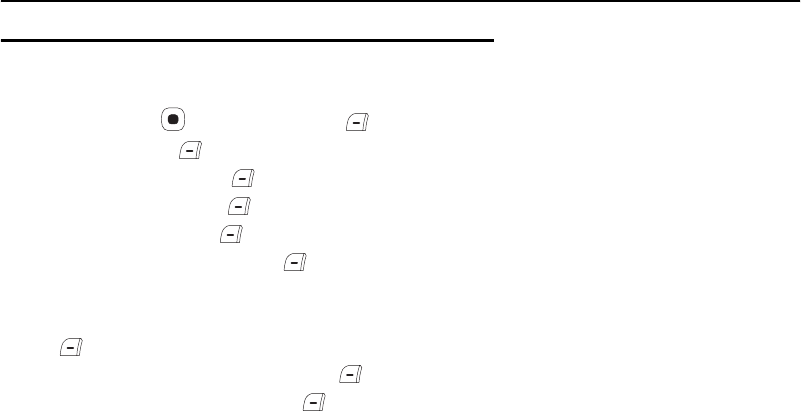
120
Camera/Video Camera
Picture & Video Settings
Settings for Taking Pictures
Changing the Picture Quality
You can change the picture quality for camera modes.
1. In standby mode, press , select Camera and press (Select).
2. Select Settings and press (Select).
3. Select Camera Settings and press (Select).
4. Select Picture Settings and press (Select).
5. Select Picture Quality and press (Select).
6. Select Fine, Normal or Economy and press (Select).
Changing the Picture Size
1. After Step 4 of “Changing the Picture Quality” (above), select Picture Size and
press (Select).
2. Select Landscape Mode or Portrait Mode and press (Select).
3. Select the picture size you want to set and press (Select).
For details on picture sizes, see page 104.

Camera/Video Camera
121
Picture Effects
You can change the colour adjustment setting for taking pictures.
1. After Step 4 of “Changing the Picture Quality” (page 120), select Picture Effects
and press (Select).
2. Select the colour adjustment you want to set and press (Select).
◆Sepia: Sepia tone picture.
◆Black & White: Monochrome picture.
◆Negative: Reverses the tones.
◆Emboss: Emphasises the contours to give an emboss look.
◆None: Normal colour picture.
Date Stamp
You can add a date stamp to pictures.
1. After Step 4 of “Changing the Picture Quality” (page 120), select Date Stamp and
press (Select).
2. Select On or Off and press (Select).
3. Select the date colour you want to set and press (Select).
Note
Date stamps cannot be added to
pictures taken in Landscape mode or
at Caller ID size.

122
Camera/Video Camera
Displaying a Grid
You can display horizontal and vertical gridlines on the monitor screen to use as a
vertical and horizontal guide for taking pictures.
1. After Step 3 of “Changing the Picture Quality” (page 120), select Screen Settings
and press (Select).
2. Select Grid and press (Select).
3. Select On or Off and press (Select).
Shutter Sound
You can set the shutter sound.
1. After Step 3 of “Changing the Picture Quality” (page 120), select Shutter Sound
and press (Select).
2. Select Pattern 1, Pattern 2 or Off and press .

Camera/Video Camera
123
Settings for Recording Videos
Changing the Video Quality
1. In standby mode, press , select Camera and press (Select).
2. Select Settings and press (Select).
3. Select Video Settings and press (Select).
4. Select Movie Settings and press (Select).
5. Select Video Quality and press (Select).
6. Select Super Fine, Fine or Normal and press (Select).
Video Effects
You can change the colour adjustment setting for recording videos.
1. After Step 4 of “Changing the Video Quality” (above), select Effects and press
(Select).
2. Select the colour adjustment you want to set and press (Select).
◆Sepia: Sepia tone video.
◆Black&White: Monochrome video.
◆Negative: Reverses the tones.
◆Emboss: Emphasises the contours to give an emboss look.
◆None: Normal colour video.
Note
The maximum recording time varies
depending on the video quality
setting.

124
Camera/Video Camera
Full Screen Display
You can display subjects and videos over the whole screen.
1. After Step 3 of “Changing the Video Quality” (page 123), select Screen Settings
and press (Select).
2. Select Screen Display and press (Select).
3. Select Normal or Full Screen and press (Select).
Setting Controller Display
You can set whether to display indicators during recording and playback.
1. After Step 3 of “Changing the Video Quality” (page 123), select Screen Settings
and press (Select).
2. Select Controller Display and press (Select).
3. Select On or Off and press (Select).
Start & End Sounds
You can set the start and end sounds.
1. After Step 3 of “Changing the Video Quality” (page 123), select Start/End Sounds
and press (Select).
2. Select Pattern 1, Pattern 2 or Off and press .
Tip
To set the Full Screen setting from
the preview screen, press
(Options) and select Full Screen.

Camera/Video Camera
125
Settings for Pictures & Videos
Self-view
This feature allows you to view the monitor screen while you take pictures or record
videos of yourself. In self-portrait style, you can use the internal camera or external
camera. In turnover style and open style, you can use the internal camera. For details
on styles, see page 24.
1. Press (Options) from the monitor screen, select Self-view and press
(Select).
2. Select Internal Camera, External Camera or Off and press (Select).
Storage Place
You can set the storage places to which to automatically save pictures and videos.
1. Press (Options) from the monitor screen, select Save Image to or Save
Video to and press (Select).
2. Select Phone Memory or Memory Card and press (Select).
If more than one folder is available for selection as the storage place, select a folder
and press (Select).
Note
All pictures taken in Landscape mode
are saved to the Digital Camera
folder.

126
Camera/Video Camera
Delay Timer
This feature allows you to take a picture or start recording after a specified time
elapses.
1. Press (Options) from the monitor screen, select Advanced and press
(Select).
2. Select Delay Timer and press (Select).
3. Select 5 sec, 10 sec, 20 sec or Off and press (Select).
Mobile Light
You can turn on the mobile light while taking pictures or recording videos.
1. Press (Options) from the monitor screen, select Advanced and press
(Select).
2. Select Mobile Light and press (Select).
3. Select On or Off and press (Select).

Camera/Video Camera
127
White Balance
Under some conditions, the colours in pictures and videos may differ from the actual
colours. If so, you can set the white balance so that the colours more closely resemble
the actual colours.
1. Press (Options) from the monitor screen, select Advanced and press
(Select).
2. Select White Balance and press (Select).
3. Select the mode you want to set and press (Select).
◆Auto: Adjusts the white balance automatically in order to obtain natural colours.
◆Daylight: Suitable for outdoors under a clear sky.
◆Shade: Suitable for in the shade.
◆Cloudy: Suitable for outdoors under a cloudy sky.
◆Fluorescent: Suitable for fluorescent lighting.
◆Tungsten: Suitable for incandescent lighting.
Exposure Control
You can adjust the brightness for pictures and videos.
1. Press (Options) from the monitor screen, select Advanced and press
(Select).
2. Select Exposure Control and press (Select).
3. Use to adjust the exposure.

128
Camera/Video Camera
Preview Setting
You can set whether to display the preview screen after you take a picture or record a
video.
1. In standby mode, press , select Camera and press (Select).
2. Select Settings and press (Select).
3. Select Camera Settings or Video Settings and press (Select).
4. Select Picture Settings or Movie Settings and press (Select).
5. Select Preview and press (Select).
6. Select On or Off and press (Select).
Flicker Adjustment
You can reduce screen flicker by setting the correct frequency for the area.
1. After Step 3 of “Preview Setting” (above), select Screen Settings and press
(Select).
2. Select Flicker Adjustment and press (Select).
3. Select 50 Hz or 60 Hz and press (Select).

Camera/Video Camera
129
Setting the File Name
You can preset the file name to use when saving pictures and videos to the date and
time or a name of your choice.
1. After Step 3 of “Preview Setting” (page 128), select File Name and press
(Select).
2. Select Date&Time or Define and press (Select).
If you selected Define, enter the file name you want to set and press .
Setting Keypad Shortcuts
You can set whether to use the keypad shortcuts for accessing functions while you are
using the camera.
1. After Step 3 of “Preview Setting” (page 128), select Keypad Shortcut and press
(Select).
2. Select On or Off and press (Select).
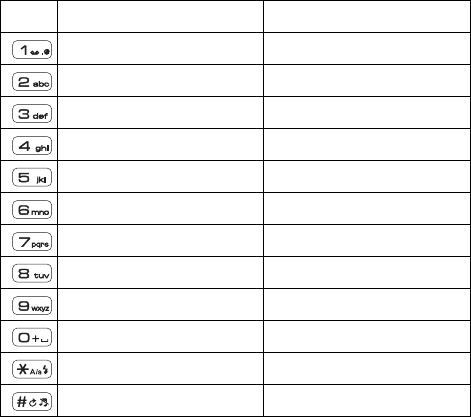
130
Camera/Video Camera
The following keypad shortcuts are available while you are taking pictures and
recording videos.
Taking Pictures Recording Videos
Key Guide Key Guide
Camera Mode Record Mode
Delay Timer Delay Timer
Picture Effects Effects
Picture Quality Video Quality
White Balance White Balance
Focus Mode Voice Record
Night Mode -
Picture Size -
-Screen Display
Mobile Light Mobile Light
Self-view Self-view